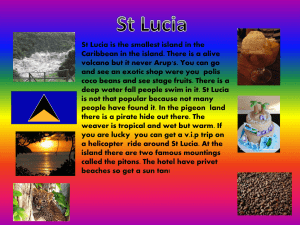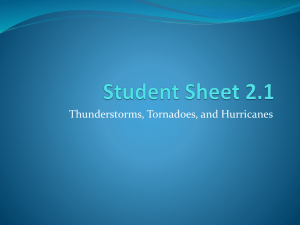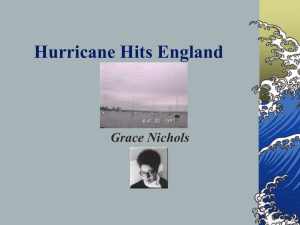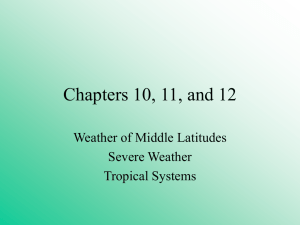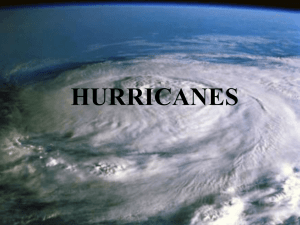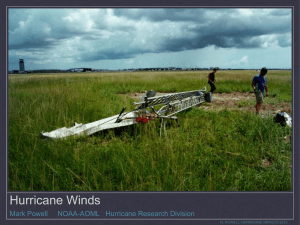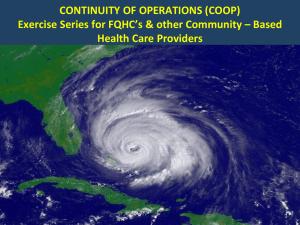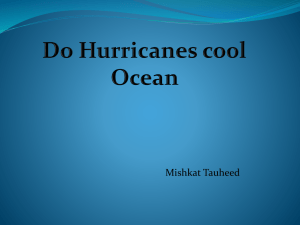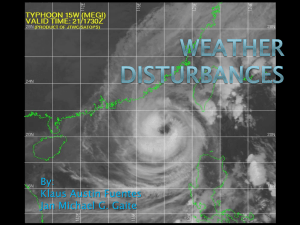Chapter_13
advertisement
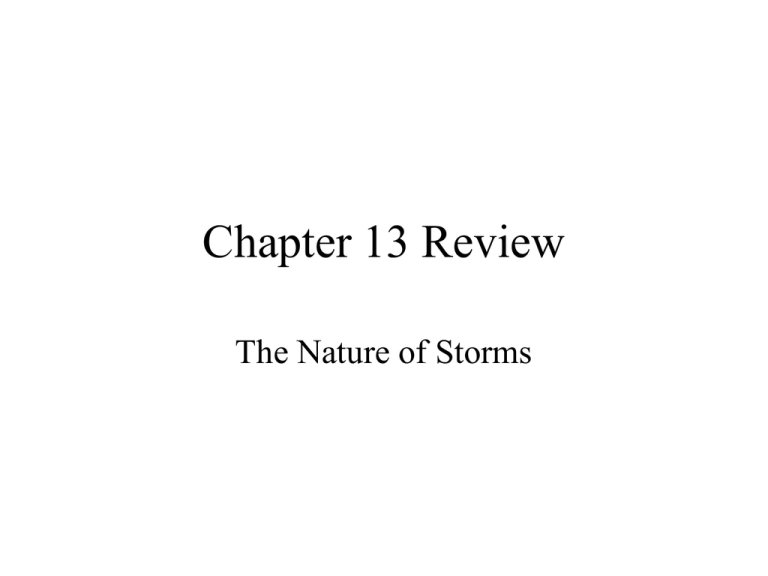
Chapter 13 Review The Nature of Storms Which is NOT a condition that must exist in order to produce a thunderstorm? 1. 2. 3. 4. a source of moisture lifting of the air mass an unstable atmosphere a source of wind 0% 1 0% 0% 2 3 0% 4 In what stage of a thunderstorm would an equal amount of updrafts and downdrafts exist? 1. 2. 3. 4. cirrus stage cumulus stage mature stage dissipation stage 0% 1 0% 0% 2 3 0% 4 What stage of a thunderstorm is shown? 1. 2. 3. 4. cirrus stage cumulus stage mature stage dissipation stage 0% 1 0% 0% 2 3 0% 4 What ultimately leads to a thunderstorm’s dissipation? 1. the production of downdrafts 2. the loss of a supply of cold air 3. the decrease in cloud droplets 4. the decrease of surface winds 0% 1 0% 0% 2 3 0% 4 Fujita Path Intensi ty Scale Durati Wind on Speed F0 up to 4 1-10 km min 70-118 km/h F1 up to 4 1-10 km min 119180 km/h F2-F3 24 km 20 min 181+ + 332 km/h F4 80 km 1 h + + 333500 km/h F5 80 km 1 h + + 501512 km/h A tornado lasts 9 minutes, is 2 km wide and has wind speeds of 99 km/h. What intensity level would it be classified? 1. 2. 3. 4. F0 F1 F2-F3 F4 0% 1 0% 0% 2 3 0% 4 Fujita Intensity Scale Path F0 up to 4 km 1-10 min 70-118 km/h F1 up to 4 km 1-10 min 119-180 km/h F2-F3 24 km + 20 min + 181-332 km/h F4 80 km + 1h+ 333-500 km/h F5 80 km + 1h+ 501-512 km/h 1. 2. 3. 4. Duration Wind Speed 181-332 km/h 333-500 km/h 500-512 km/h 119-180 km/h How fast must the winds of a tornado be traveling to be classified as a F4 tornado? 0% 1 0% 0% 2 3 0% 4 Fujita Intensity Scale Path F0 up to 4 km 1-10 min 70-118 km/h F1 up to 4 km 1-10 min 119-180 km/h F2-F3 24 km + 20 min + 181-332 km/h F4 80 km + 1h+ 333-500 km/h F5 80 km + 1h+ 501-512 km/h 1. 2. 3. 4. 332 km/h 485 km/h 502 km/h 510 km/h Duration Wind Speed 0% 1 0% 0% 2 3 A tornado has lasted for 70 minutes and its path was 84 km wide. What would its wind speed have to be in order for it to be categorized as an F4 tornado? 0% 4 When a storm over an ocean has wind speeds of 75 km/h what can it be classified as? 1. a hurricane 2. a tropical depression 3. a tropical storm 4. a cyclone 0% 1 0% 0% 2 3 0% 4 1. 2. 3. 4. the eye the eyewall the rainbands the outer edge At which point would the strongest winds and densest clouds of the hurricane be located? 0% 1 0% 0% 2 3 0% 4 What is characteristic of the eye of the hurricane? 1. the strongest winds and densest clouds 2. thunderstorms 3. light clouds and precipitation 4. calm weather and blue sky 0% 1 0% 0% 2 3 0% 4 Because the hurricane is moving in a counterclockwise direction, what can be inferred about this hurricane? 1. 2. 3. 4. The moving tropical disturbance which caused this hurricane came from the west. The moving tropical disturbance which caused this hurricane came from the east. This hurricane is occurring in the northern hemisphere. This hurricane is occurring in the southern hemisphere. 0% 1 0% 0% 2 3 0% 4 Category Winds (km/h) Change in sea level Damage 5 >250 >5.5 m catastrophic 4 210-249 4.0-5.5 m extreme 3 178-209 2.8-3.7 m extensive 2 154-177 1.8-2.5 m moderate 1 119-153 1.2-1.5 m minimal A hurricane has been classified as a category 3 hurricane. Which of the following is NOT true? 1. the hurricane can not get any stronger 2. the hurricane has winds of 200 km/h 3. the hurricane can not get any weaker 4. the hurricane has sea level changes of 4.0 m 0% 1 0% 0% 2 3 0% 4 Category Winds (km/h) Change in sea level Damage 5 >250 >5.5 m catastrop hic 4 210-249 4.0-5.5 m extreme 3 178-209 2.8-3.7 m extensive 2 154-177 1.8-2.5 m moderate 1 119-153 1.2-1.5 m minimal 0% 0% 0% 0% 1. 2. 3. 4. catastrophic moderate extensive extreme A hurricane hits land with wind speeds of 225 km/h and sea level changes of 5.5 m. What damage classification would it be labeled as according to the Saffir-Simpson Hurricane Scale? Air Tempera ture (ºF) 75 80 85 90 Relative Humidit y (%) Apparent Tempera ture (ºF) 0 69 73 78 83 10 70 75 80 85 20 72 77 82 87 30 73 78 84 90 40 74 79 86 93 50 75 81 88 96 60 76 82 90 100 70 77 85 93 106 80 78 86 97 113 90 79 88 102 100 80 91 108 122 All public pools in a local city are free when the heat index is at least 90°F. What is the minimum amount of relative humidity needed for the pools to be free if the air temperature is 85°F? 1. 2. 3. 4. 60% 10% 80% 50% 0% 1 0% 0% 2 3 0% 4 Air Tempera ture (ºF) 75 80 85 90 Relative Humidit y (%) Apparent Tempera ture (ºF) 0 69 73 78 83 10 70 75 80 85 20 72 77 82 87 30 73 78 84 90 40 74 79 86 93 50 75 81 88 96 60 76 82 90 100 70 77 85 93 106 80 78 86 97 113 90 79 88 102 122 100 80 91 108 What air temperature and relative humidity produces the same apparent temperature as when the air temperature is 90°F and the relative humidity is 40%? 1. 2. 3. 4. 70°F, 85% 75°F, 90% 85°F, 60% 85°F, 70% 0% 1 0% 0% 2 3 0% 4 Flooding occurs if an area receives 27 cm of total rainfall. If a storm lasts for 21 hours with a rainfall rate of 1.5 cm/h would the area become flooded? 1. Yes, because the area would receive 31.5 cm of rain. 2. No, because the area would receive 21 cm of rain. 3. Yes, because the area would receive 315 cm of rain. 4. Yes, because the area would receive 40.5 cm of rain. 0% 1 0% 0% 2 3 0% 4 A(n) ____ thunderstorm forms because of unequal heating of Earth’s surface within one air mass. 1. 2. 3. 4. frontal mass cold front air mass air pressure 0% 1 0% 0% 2 3 0% 4 The rising, moist updrafts and the falling, cool downdrafts form a convection cell that produces the ____ associated with thunderstorms. 1. temperatures 2. thunder 3. humidity 4. gusty surface winds 0% 1 0% 0% 2 3 0% 4 Very severe thunderstorms can form when a ____ has a large continuous supply of warm air to lift and condense. 1. 2. 3. 4. cold front warm air mass warm front tornado 0% 1 0% 0% 2 3 0% 4 When friction between updrafts and downdrafts within a cumulonimbus cloud creates regions of air with opposite charges, ____ forms. 1. 2. 3. 4. warm air lightning precipitation ozone 0% 1 0% 0% 2 3 0% 4 ____ are often associated with very severe thunderstorms called supercells. 1. 2. 3. 4. Tornadoes Sea breezes Hurricanes Heat waves 0% 1 0% 0% 2 3 0% 4 A mound of water driven toward coastal areas by hurricane winds is called a ____. 1. 2. 3. 4. cyclone supercell storm surge cold front 0% 1 0% 0% 2 3 0% 4 An extended period of wellbelow-normal rainfall is a ____. 1. 2. 3. 4. flood drought heat wave tropical cyclone 0% 1 0% 0% 2 3 0% 4 The phenomenon in which the effects of cold air are worsened by wind is the ____. 1. supercell 2. sea breeze 3. wind chill factor 4. cold wave 0% 1 0% 0% 2 3 0% 4 Air under a large high-pressure system sinks, warms, and causes above-normal temperatures 1. cold wave 2. drought 3. heat wave 0% 1 0% 2 0% 3 High pressure associated with continental polar or arctic air 1. cold wave 2. drought 3. heat wave 0% 1 0% 2 0% 3 Large, persistent high-pressure system associated with extended periods of below-normal rainfall 1. cold wave 2. drought 3. heat wave 0% 1 0% 2 0% 3 1. True 2. False Diagram A would most likely occur during the night. 0% 1 0% 2 The weather in diagram A is more likely to produce a thunderstorm than the weather in diagram B. 1. True 2. False 0% 1 0% 2 The weather in diagram B would be considered stable. 1. True 2. False 0% 1 0% 2 1. True 2. False 0% 1 0% 2 The air circulates counterclock wise in diagram B because the water cools slower than the land. The cumulonimbus clouds associated with thunderstorms form from cumulus clouds and convection. 1. True 2. False 0% 1 0% 2 All tropical cyclones thrive on the energy in warm and cold air masses. 1. True 2. False 0% 1 0% 2 A Category 2 hurricane on the Saffir-Simpson hurricane scale is more dangerous than a Category 5 hurricane. 1. True 2. False 0% 1 0% 2
